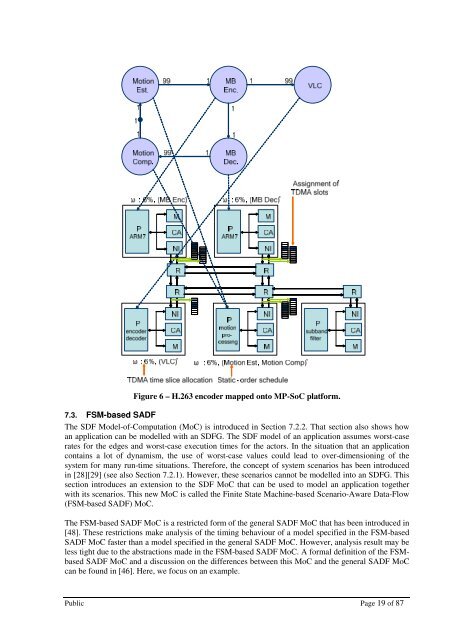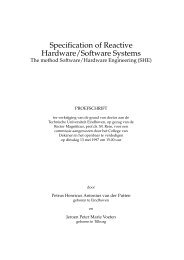MNEMEE - Electronic Systems - Technische Universiteit Eindhoven
MNEMEE - Electronic Systems - Technische Universiteit Eindhoven
MNEMEE - Electronic Systems - Technische Universiteit Eindhoven
Create successful ePaper yourself
Turn your PDF publications into a flip-book with our unique Google optimized e-Paper software.
Figure 6 – H.263 encoder mapped onto MP-SoC platform.<br />
7.3. FSM-based SADF<br />
The SDF Model-of-Computation (MoC) is introduced in Section 7.2.2. That section also shows how<br />
an application can be modelled with an SDFG. The SDF model of an application assumes worst-case<br />
rates for the edges and worst-case execution times for the actors. In the situation that an application<br />
contains a lot of dynamism, the use of worst-case values could lead to over-dimensioning of the<br />
system for many run-time situations. Therefore, the concept of system scenarios has been introduced<br />
in [28][29] (see also Section 7.2.1). However, these scenarios cannot be modelled into an SDFG. This<br />
section introduces an extension to the SDF MoC that can be used to model an application together<br />
with its scenarios. This new MoC is called the Finite State Machine-based Scenario-Aware Data-Flow<br />
(FSM-based SADF) MoC.<br />
The FSM-based SADF MoC is a restricted form of the general SADF MoC that has been introduced in<br />
[48]. These restrictions make analysis of the timing behaviour of a model specified in the FSM-based<br />
SADF MoC faster than a model specified in the general SADF MoC. However, analysis result may be<br />
less tight due to the abstractions made in the FSM-based SADF MoC. A formal definition of the FSMbased<br />
SADF MoC and a discussion on the differences between this MoC and the general SADF MoC<br />
can be found in [46]. Here, we focus on an example.<br />
Public Page 19 of 87
















